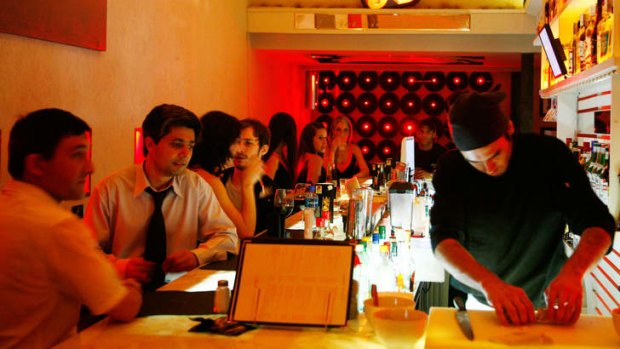
Local yokels: a bar in Palermo Soho, Buenos Aires.Credit: Alamy
From the latest cool threads in Tokyo to the best amber fluid in Amsterdam, and from a drinkable latte in London to vintage shopping in Singapore, Traveller on Sunday's writers, on the spot around the world, have hunted down the hottest neighbourhoods to visit in six major cities.
Once, a holiday to one of the world's great cities was inevitably spent in queues, waiting to tick off the top attractions, to return home with a bulging album of snaps or slides.
The citizens of these cities, however, don't reside in towers, museums and galleries. They live in neighbourhoods, just like us, often vibrant, atmospheric places that are often ignored or overlooked by visitors.
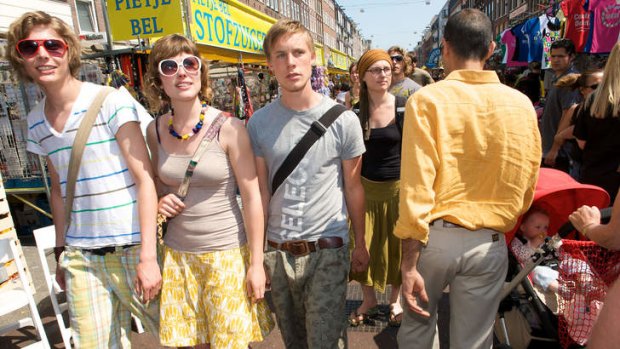
A stroll through Albert Cuyp Market .Credit: Alamy
It's in these places that you get an authentic taste of how the people live, eat, drink and play. Here, in a sequel to last year's Traveller on Sunday cover story on the hottest hoods around Australia, is our international version with our favourite areas in New York, Tokyo, London, Singapore, Buenos Aires and Amsterdam, penned by our expert writers who pounded the pavements to find the best of each area.
NEW YORK
WHERE Harlem
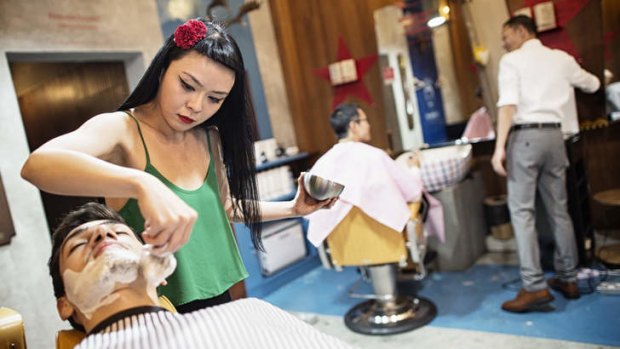
We Need a Hero barber in Tiong Bahru, Singapore.
WHY HERE? Ever since chef and restaurateur Marcus Samuelsson opened Red Rooster Harlem (redroosterharlem.com) three years ago, there has been an explosion of upscale spots to eat, drink and party. There is a sense that a new chapter in Harlem's rich culture, history and evolution is being written. Apartment rents are on the up, construction has begun on a new Whole Foods in 125th Street, and "mom'n'pop" storefronts are being pushed further north. Now is the time to see old-school Harlem before gentrification smooths away the quirky characters.
THE LOWDOWN Harlem has been called the centre of black culture, the centre of cool. If you want culture, history, good times, bad times, survival, renewal and irresistible street swagger, you will find it here. It is jazz in a club where Duke Ellington thrilled and chilled (showmansjazzclub.com). It is the best pulled pork and barbecued chicken wings you ever tasted (dinosaurbarbque.com). It is gospel church on Sunday morning (fcbcnyc.org), then brunch in the afternoon at Bier International (bierinternational.com) or Harlem Tavern (harlemtavern.com). Catch an exhibition at Studio Museum Harlem (studiomuseum.org) to see the neighbourhood and the world through the eyes of local and international artists. Don't forget to buy a "Black is Beautiful" mug in the museum store. Or sit in one of Harlem's outdoor spaces, such as Marcus Garvey Park, Riverside Park and Morningside Park, and watch the passing parade of African ladies in traditional headdress, teenagers shooting hoops, sharp-suited real estate brokers and baby strollers.
DON'T MISS ... Everyone loves the late-night cheese melts at Harlem Shake (harlemshakenyc.com) across the street from Red Rooster Harlem. On Wednesday nights at the Apollo Theatre (apollotheater.org) amateur entertainers take to the famed stage that launched the careers of Stevie Wonder, Michael Jackson, Ella Fitzgerald, James Brown and Lauryn Hill.
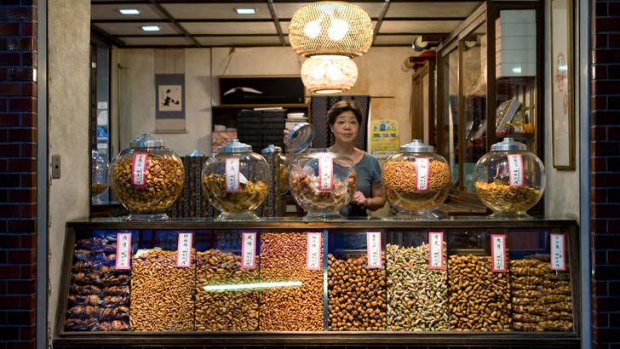
A store in Shimokitazawa, Tokyo.Credit: ALAMY
Kristie Kellahan
TOKYO
WHERE Shimokitazawa
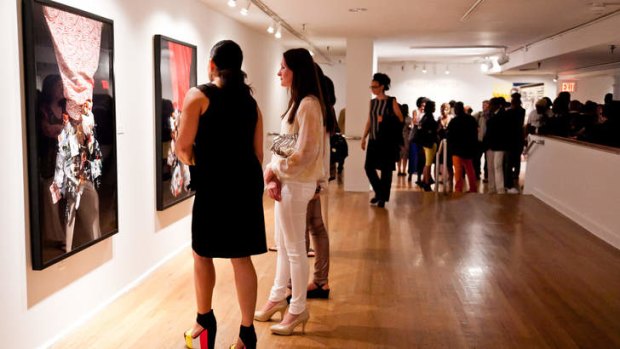
Studio Museum Harlem.
WHY HERE? Tokyo has many intriguing precincts, such as Ginza, Harajuku, Shinjuku and Akihabara, well trodden for their shopping, busy streets and maid cafes, but Shimokitazawa is less visited by tourists and its narrow streets and alleyways embrace the vintage culture. Even though you won't be overrun by tourists, Shimokitazawa is popular with Japanese university students. They go for the trendy second-hand stores selling clothes, jewellery, homewares and trinkets. The reasonably priced izakaya (pub-style) eating and drinking is another lure.
THE LOWDOWN It's creative, bohemian and so cool here, whether its a Lolita riding by on a black vintage bike, a group of students sucking on a shisha pipe at street tables outside a cafe or live music in tiny venues. Little English is spoken, but that's half the fun. One waiter confirms an order for yakatori chicken-thigh skewers by flapping his arms and doing a stabbing motion into his thigh. The pedestrian-friendly laneways are stuffed with shops and bars. It's best to explore for yourself, because there are about 1500 shops in 500 square metres, but be sure to see the Shimokita Garage Department, described by Lonely Planet as a "flea market with treasures galore". Also, go to Haight and Ashbury for vintage clothes, Flamingo for vintage clothes that sometimes go for a bargain, Village Vanguard (village-v.co.jp) for pop culture, the Japanese fashion store Cune (cune.jp), the miniature bar Idiot Savant, and Bar Mother where the Rolling Stones and the Doors spin on vinyl. There are many cafes, such as the retro-styled Bear Pond Espresso (bear-pond.com) and JS Pancake Cafe, that are helping fuel the Japanese penchant for pancakes. Make sure you look up the staircases too, because many of the shops are on the second floor of the cute buildings that line the almost traffic-free streets.
DON'T MISS ... Katsu is a lively izakaya (Japanese pub). Aside from Asahi beer to go with the yakatori skewers, it has a big variety of shochu (distilled spirits from sweet potatoes/buckwheat). When we leave, a waitress rushes outside to spray us with air freshener to rid our clothes of the smoky smell from the grill.
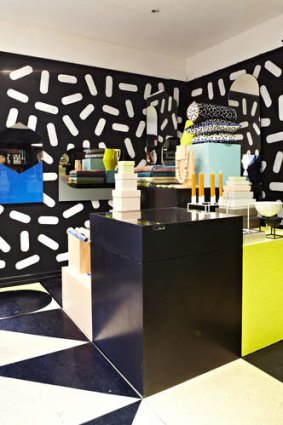
Darkroom, in Lamb's Conduit Street, London.
Robert Upe
LONDON
WHERE Lamb's Conduit Street, London
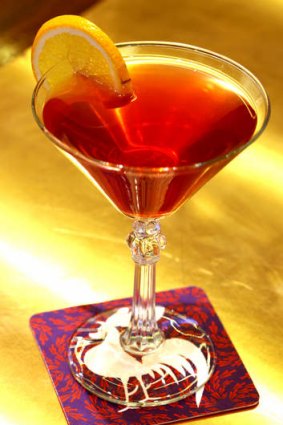
A drink at the Red Rooster, Harlem.Credit: Paul Brissman
WHY HERE? This quirkily named, street in Bloomsbury, part of the Borough of Camden, emerged recently as a new hub for contemporary menswear, but there's much more to this relaxed, partially pedestrianised high-street, lined with stately Georgian townhouse-style buildings, than it seems. There's plenty to keep both male and female visitors amused, what with the spattering of restaurants, cafes and design shops not just along Lamb's Conduit, but in the side streets too.
THE LOWDOWN Lamb's Conduit Street is best visited during the day when all the shops are open. Once known for its independent menswear outlets, the street now attracts mainstream labels such as J Crew (jcrew.com), but, being relatively tourist-free, it remains a more sane retail alternative to Oxford and Regent streets. For something more out there, try Private White VC (privatewhitevc.com), a Manchester-based label that specialises in like-it-or-loathe-it military-influenced clobber. Across the street is Darkroom (darkroomlondon.com), which stocks unusual, hard-to-find and one-off accessories for men, women and the home. Perfect for a pit-stop is the Espresso Room (theespressoroom.com), a hip, hole-in-the-wall joint in Great Ormond Street, just around the corner from Lamb's Conduit Street. A relief from London's chain coffee houses, it is like being in inner-city Sydney or Melbourne. As it turns out, the English owner derived his inspiration from time spent in Australia's caffeine-obsessed culture.
DON'T MISS ... Spend a leisurely lunch at the buzzy, Spanish-themed Cigala (cigala.co.uk), a popular haunt, as befitting its Bloomsbury location, for legal and publishing professionals. There are good-value set menus at lunchtime, but do book, as it gets busier than a bullfighter at a cattle auction. If there isn't enough for you in Lamb's Conduit Street, there's the Charles Dickens Museum (dickensmuseum.com), located in a former home of the author, just a few blocks away.
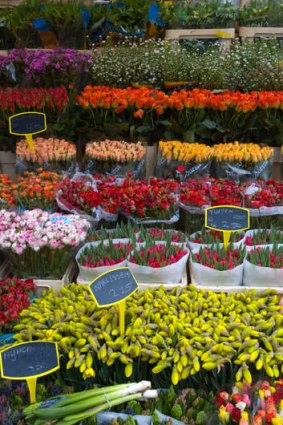
Attractive bargains: the daily Albert Cuyp market is the place to shop in Amsterdam.Credit: Alamy
Anthony Dennis
BUENOS AIRES
WHERE Palermo
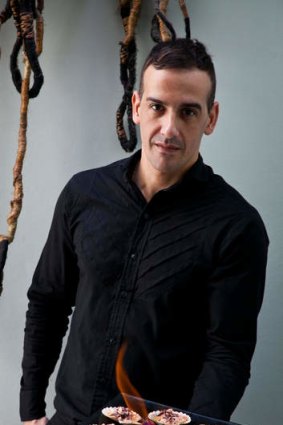
Tasty treats at Osaka restaurant in Palermo, Buenos Aires, Argentina.Credit: Alamy
WHY HERE? Once a quiet, upmarket neighbourhood at the north-east margin of the Argentine capital, Palermo is now a city unto itself, with its own sub-barrios (neighbourhoods) that keep adding arty, trendy fringe elements to a core of tourist-friendly commerce. Between the parks and plazas, there's not much local history to speak of, with most of the old, low houses long since replaced by cafes, bars and boutiques, it's always present day in Palermo, and it never really falls out of fashion.
THE LOWDOWN Palermo Soho, named after its supposed resemblance to the bohemian quarter of New York, draws the biggest crowds to the streets around Plaza Serrano, especially for the weekend market of independent vendors. Two blocks away in Calle Gurruchaga (Gurruchaga Street) there's a great run of specialist clothing stores, including 28 Sport (28sport.com), for lovingly made vintage-style footwear. You will find fresher coffee at the relatively new Full City Coffee House (fullcitycoffeeco.com) than in most of the city's older cafes and, if you want a beer, you will find a better-brewed alternative to Argentina's generally poor domestic product at Bodega Cervecera (bodegacervecera.com.ar) down the street. The roof terrace at Esquina Libertad is a pretty ideal place to sit out happy hour with a cheap cocktail or a full pint of your chosen spirit and mixer.
Various Palermo parrillas (grill restaurants) uphold the city's claim to being the steak capital of the world. La Cabrera is the best known (parrillalacabrera.com.ar), and Lo De Jesus is perhaps the most old-school in terms of no-frills neighbourhood appeal (lodejesus.com.ar).
DON'T MISS ... Palermo's secret bar scene. As the regular bars become more popular, discerning locals have disappeared to exclusive cocktail venues, behind hidden doors and whispered passwords. Hints on Twitter and Facebook should help you gain entry to Frank's Bar (franks-bar.com) at 1445 Arevalo and its newer gin-joint sister, The Harrison Speakeasy, at 1764 Malabia.
Stephen Phelan
SINGAPORE
WHERE Tiong Bahru
WHY HERE? It is one Singapore's oldest housing estates and its charming streets have recently seen an explosion of boutique food and drink venues, street art and one-off vintage shopping, while still retaining their old-school charm and traditional hawkers.
THE LOWDOWN In the past few years, the curvaceously beautiful low-rise estates around Tiong Bahru have become home to a diverse mix of people - local hipsters, artists, old timers and expatriates - drawn to the art deco beauty as an antidote to the high-rises rampant on the rest of the island. Eng Hoon Street is the epicentre of the area. The most obvious manifestation of the old and new aesthetic here is Two Face Pizza & Taproom (twoface.sg), which is a traditional kopitiam (coffee shop) by day and bustling pizza joint and bar by night full of Singaporean hipsters and well-off expatriates. To get the required facial fuzz, many of the diners will have visited We Need a Hero (weneedahero.sg), a dark-wood retro barber nearby known for its straight-razor shaves and facial sculpting. For women, one-off vintage dresses can be found in Nana & Bird. If you are after a cheap meal at any time of the day, try the Tiong Bahru Market at 89 Seng Poh Road, an indoor-outdoor hawker in one of the art deco blocks that offers everything from chicken rice to roti prata.
DON'T MISS ... The bakery that launched a thousand cupcake-toting imitators. Tiong Bahru Bakery (tiongbahrubakery.com) is widely credited with starting the trend for baked delicacies that has spread island-wide. Founder, French baker and TV chef Gontran Cherrier makes sure that all things francais are on en pointe, but try the signature kouign-amann, a crusty cake from Breton, or one of the bakery's famous squid ink sandwiches for a quick lunch. At night, pull up a pew at the Coq & Balls (coqnballs.com), which has a simple, welcoming interior and great range of craft beers, ciders and classic cocktails.
Paul Chai
AMSTERDAM
WHERE De Pijp, Amsterdam
WHY HERE, WHY NOW? Students, artists, musicians, actors and other bohemians have much in common with tourists: they like places that are lively, interesting and cheap. De Pijp (pronounced "pipe"') is the Latin Quarter of Amsterdam. Tourists sometimes choke the elegant, upmarket canal belt but De Pijp better reflects Amsterdam's multicultural population, with a lively mix of Moroccan, Turkish and Asian shops and restaurants. It was developed in the 19th century to provide modest housing for working people and, for much of its history, was considered the rough end of town. Now, its small apartments perfectly suit the young, single and hip.
THE LOWDOWN In De Stadskantine (destadskantine.nl), students pore over laptops enjoying the free Wi-Fi. Coffee and a fine toasted sandwich cost less than €6 ($9). Hutspot (hutspotamsterdam.com) features work by up-and-coming designers, selling everything from bamboo bikes to African-print T-shirts. You can get a coffee and buy the table and the cup, or have your hair cut and take away an antique barber's chair. Stroll round P. L. Takstraat to see prime examples of the Amsterdam School of Architecture - affordable housing created during the 1920s and '30s. Note the tiny ladder windows, designed to stop residents from lowering the tone of the streetscape by hanging out the washing. On the fringe of De Pijp is the Heineken Brewery (heineken.com), now a museum of amber fluid. At night, de Badcuyp (badcyp.nl) has food and live jazz. Rialto Cinema (rialtofilm.nl) screens a program of alternative films. For a sunny terrace by day and popular bar by night, try Cafe Wildschut (cafewildschut.nl).
DON'T MISS ... The Albert Cuyp market (albertcuypmarkt.nl), the largest daily (except Sundays) market in the Netherlands. It's the place to buy cheap jewellery, souvenirs or clothes, or Dutch bread, cheese and raw herring to take on a picnic in nearby Sarphati Park.
TRIP NOTES
NEW YORK
Harlem is a district in Upper Manhattan, stretching north from the top of Central Park at 110th Street all the way to 155th Street. The centre of all things Harlem is 125th Street, West Side, easily reached by a 30-minute subway ride from Times Square on the A, B, C, D, 2 or 3 lines. Stay at the centrally located Aloft Harlem (alofthotels.com/Harlem).
TOKYO
From Shinjuku (one of the central areas where tourists stay) it's a seven-minute train ride to Shimokitazawa on the Odakyu Line (tokyometro.jp/en/). Shimokitazawa is a quiet residential area, but Airbnb has some apartments there. One good, affordable bet is the Ibis hotel at Shinjuku (ibis.com/ja). The three-star rooms are tiny but Wi-Fi is free and the basic breakfast good.
LONDON
The nearest tube station (tfl.gov.uk/modes/tube/) to Camden's Lambs Conduit Street is Russell Square. Kings Cross Station is just a few stops away making the newly restored, 91-room Great Northern Hotel (gnhlondon.com) a worthy accommodation option. It's a former railway hotel from the 19th century that's been turned into smart boutique digs for the Eurostar crowd.
BUENOS AIRES
Just north of the city centre, Palermo sprawls out from Avenida Santa Fe, with most major cross-town bus routes and the D-line of the Subte metro system stopping right in the heart of the barrio. The compact and ultra-stylish Legado Mitico boutique hotel offers 11 custom-designed "mythic rooms" in an original Palermo townhouse (legadomitico.com/en).
SINGAPORE
Tiong Bahru is located in the south-west of the island. It is a 20-minute walk from tourist-happy Chinatown or accessible via the Singapore MRT at Tiong Bahru station on the East-West Line. Looking like a giant beer barrel, boutique hotel Wangz is the area's best option for staying the night (231 Outram Road, wangzhotel.com) and it also has a well-respected rooftop bar. There is no bad time to visit Tiong Bahru, by day it is bustling with coffee shops and the smell of artisan baking, by night busy bars and late-night hawkers visit to sate the munchies.
AMSTERDAM
Catch Tram 16 or 24 from Amsterdam Centraal Station to the Albert Cuypstraat (13 minutes) in the heart of the Pijp. Or walk or ride the bike, following the Amstel River - it won't take much longer. Cityden's Rijksmuseum Residence offers self-contained apartments in the Pijp from €167 ($240) a night (usually with a three-night minimum stay). See cityden.com.
MORE INFORMATION
nycgo.com; gotokyo.org/en; visitbritain.com; argentina.travel/en; yoursingapore.com; iamsterdam.com.
Sign up for the Traveller Deals newsletter
Get exclusive travel deals delivered straight to your inbox. Sign up now.